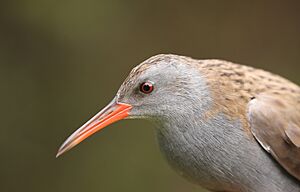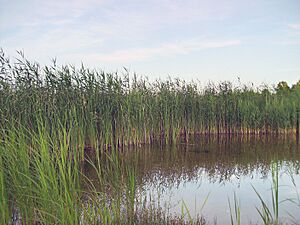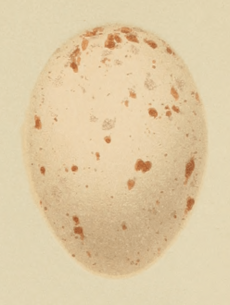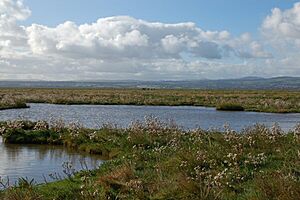Water rail facts for kids
Quick facts for kids Water rail |
|
|---|---|
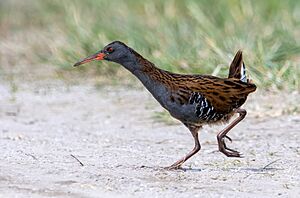 |
|
| Conservation status | |
| Scientific classification | |
| Genus: |
Rallus
|
| Species: |
aquaticus
|
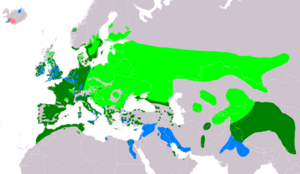 |
|
| Range of R. aquaticus Breeding Resident
Non-breeding Probably extinct |
|
The water rail (Rallus aquaticus) is a cool bird that belongs to the rail family. It lives and has its babies in wet, marshy places with lots of plants across Europe, Asia, and North Africa.
Some water rails fly south for the winter, especially those from colder northern and eastern areas. But in warmer places, they stay put all year round.
Adult water rails are about 23 to 28 centimeters (9 to 11 inches) long. Like other rails, their bodies are flat from side to side. This helps them squeeze easily through the thick reed beds where they live.
They have brown feathers on their backs and blue-grey feathers underneath. Their sides have black stripes. They also have long toes, a short tail, and a long, reddish beak. Young water rails look a lot like the adults, but their blue-grey parts are more of a pale yellow-brown. Baby water rails are black and fluffy, just like all rail chicks. There's a type of water rail from Asia, called the brown-cheeked rail, that used to be thought of as the same species. But now, scientists usually consider it a separate species because it looks and sounds different.
Water rails build their nests in reed beds and other marshy spots with tall, thick plants. They build their nests a little above the water using plants they find nearby. The eggs are off-white with spots. The female bird usually sits on the eggs to keep them warm. The fluffy chicks hatch in about 19 to 22 days. If someone finds her nest, the female will protect her eggs and babies. She might even move them to a new, safer spot!
These birds can start having babies after their first year. They usually have two groups of babies (called clutches) each year. Water rails eat all sorts of things. In summer, they mostly eat small bugs and other tiny creatures. As winter gets closer, they eat more berries and plant stems. They are very protective of their space, even after breeding season. They will bravely defend their feeding areas in winter.
Water rails can be in danger from floods or very cold weather. They also face threats from losing their homes (habitats) and from animals that hunt them, like some mammals and large birds. For example, the American mink, which was brought to some places by humans, has caused some water rail groups on islands to disappear. But overall, there are many water rails across a huge area, so they are not considered to be in danger of disappearing completely.
Contents
About Water Rails
What is a Water Rail?
The water rail is a bird that belongs to a group called rails. This family has about 150 different kinds of birds. Scientists think that most rails first appeared in the "Old World" (Europe, Asia, and Africa). However, the group of rails that the water rail belongs to, called Rallus, first appeared in the "New World" (the Americas).
The water rail was first officially described by a famous scientist named Carl Linnaeus in 1758. He gave it the scientific name Rallus aquaticus. This name is Latin for "water rail," which is what people in England were already calling it.
Water Rail Family Tree
Scientists have found that the water rail is closely related to some rails from the Pacific Ocean. There used to be a subspecies called R. a. indicus. It had very different calls from the water rail we usually see. Now, most scientists agree that this is a separate species, the brown-cheeked rail. It's thought that these two types of rails became separate species about 534,000 years ago.
Ancient Water Rails
The oldest known bones of an ancient water rail were found in the Carpathian Mountains. They are from about 1.8 to 5.3 million years ago! By about 2 million years ago, water rails were living in most of the places they live today.
Scientists also found bones of a smaller, stronger rail on an island called Ibiza. This bird, called the Ibiza rail, probably couldn't fly very well. It disappeared around the same time humans arrived on the island, many thousands of years ago.
What Does a Water Rail Look Like?
An adult water rail is a medium-sized bird. It's about 23 to 28 centimeters (9 to 11 inches) long, with a wingspan of 38 to 45 centimeters (15 to 18 inches). Males usually weigh a bit more than females.
Their backs, from their forehead to their tail, are olive-brown with black stripes. Their face and chest are dark blue-grey, but they have a blackish spot between their beak and eye. Their sides have cool black and white stripes. Their tail feathers underneath are white with some darker lines.
They have a long, red beak and red eyes. Their legs are a brownish-pink color. Males and females look pretty similar. Young water rails have a blackish head and a white chin. Their undersides are pale yellow-brown or white with darker stripes. Their side markings are brown and pale yellow-brown instead of black and white. Their eyes, beak, and legs are not as bright as an adult's.
Baby water rails are completely black, except for a mostly white beak. After breeding season, water rails lose all their old feathers and grow new ones. During this time, they can't fly for about three weeks. Each adult water rail has unique markings under its tail, which helps scientists tell them apart!
You can easily tell a water rail apart from most other marsh birds because of its white undertail and red beak. The water rail's beak is a bit longer than its head and curves slightly downwards.
What Sounds Do Water Rails Make?
Water rails are quite noisy birds! They make a special call, often described as "sharming," all year long. It sounds like a series of grunts followed by a high-pitched squeal, like a piglet, and then more grunts. They use this call to mark their territory, warn others of danger, or just to announce their presence.
When a pair of water rails calls, the male makes lower, slower sounds than the female. Their courtship song, sung by both birds, is a "tyick-tyick-tyick" sound that often ends with a trill from the female. The male might sing for hours! When they fly, they make a sharp whistle. Other sounds include a loud creak from the male when he shows the female the nest spot, and a purring sound from both parents when they are with their chicks. They are loudest when they are setting up their home and early in the breeding season. They might even call at night!
Baby water rails start with weak cheeps, but soon they learn a "tyk-tyk-trik" sound to beg for food.
Different Kinds of Water Rails
There are three main types, or subspecies, of water rails:
- R. a. aquaticus: This is the most common type. It lives in Europe, North Africa, Turkey, and parts of Asia.
- R. a. hibernans: This type lived in Iceland. It had slightly warmer brown feathers on its back and dark brown stripes on its sides. Sadly, this group became extinct around 1965.
- R. a. korejewi: This type lives in south-central Asia, from Iran to Eastern China, and in parts of India. It's a bit bigger than the common water rail and has paler brown feathers.
Where Do Water Rails Live?
Water rails live across many parts of Europe and Asia, from Iceland and Ireland all the way to North Africa, Saudi Arabia, and western China. We don't know as much about where they live in Asia.
The water rails in Iceland (R. a. hibernans) died out around 1965. This happened because their wetland homes were drained, and because of predators like the American mink that were brought to the island by humans.
Water rails that live in warmer southern and western areas stay there all year. But those from places with harsh winters fly south. They spend winter in their breeding areas or even further south in North Africa, the Middle East, and near the Caspian Sea. They usually fly south in September and October, and return home from March to mid-April.
Water Rail Homes
Water rails like to live in places that are always wet, with still or slow-moving fresh or slightly salty water. They need lots of tall, thick plants like common reed, reedmace, or irises. These plants give them good cover. They prefer places where the plants are standing in water about 5 to 30 centimeters (2 to 12 inches) deep, with muddy areas for finding food. They also like places with nearby willow trees or bushes.
They can live in natural marshes, but also in places like old gravel pits or peat workings, as long as there's good plant cover. You might even find them in rice fields or on floating islands! One study showed that the most important thing for water rails is how much plant cover there is. The more plants, the more water rails!
Sometimes, water rails choose unusual places to nest. One pair in Scotland nested right next to a road! And in an English nature reserve, some nested inside or under special nest boxes made for other birds. Even though they mostly live in lowlands, water rails can breed at high altitudes, up to 1,240 meters (4,000 feet) in the Alps and 2,000 meters (6,500 feet) in Armenia.
In winter, they might use more kinds of wet places, like flooded bushes. If it gets very cold and everything freezes, they might be forced into more open areas like ditches, trash dumps, or even gardens. Some water rails in Iceland survive winter by using warm streams heated by the Earth's warmth. They might even go through tunnels under the snow to reach these streams!
How Water Rails Behave
Water rails are very shy birds. Their striped feathers help them hide in their wetland homes. Their flat bodies let them slip through the thickest plants. If you surprise them in the open, they will "freeze" and stay perfectly still.
They walk with high steps, but if they need to hide quickly, they will crouch down and run. They can swim with jerky movements, like other rails. They fly short distances low over the reeds, with their long legs dangling. Even though their flight looks weak, water rails can fly long distances during their night migrations. Sometimes, they accidentally hit lighthouses or wires. Birds tagged in Britain have been found as far away as Poland and Sweden!
Water rails protect their homes and feeding areas, both when they are breeding and in winter. When breeding, they might charge at each other with their necks stretched out. Sometimes, both birds in a pair will attack together. In winter, bigger, stronger males are usually in charge. Instead of direct attacks, they might make their "sharming" call while standing tall on their tiptoes, jerking their heads and pointing their beaks down.
Water Rail Reproduction and Life Cycle
Water rails usually have one partner for life and are very protective of their territory when they are breeding. They find their partners when they arrive at their nesting areas, or even before they fly north in spring. In big wetlands with good conditions, nests might be only 20 to 50 meters (22 to 55 yards) apart.
The male chooses the nest spot. He shows it to the female by puffing up his back feathers, arching his wings, spreading his tail, and pointing his beak straight down. He makes a loud call during this display. Before mating, he raises his wings and tail and bows with his beak touching his chest. The male feeds the female during courtship. When she is sitting on the eggs, she might leave the nest to show off to the male, walking around him, calling softly, rubbing her beak against his, and taking short runs.
The nest is built mostly by the male, usually in just one day, using whatever wetland plants are available. It's built about 15 centimeters (6 inches) or more above the water. Sometimes it's on roots, tree stumps, or other supports. If the water level rises, they might build the nest even higher. The nest is well hidden and has narrow paths leading to it.
A typical group of eggs (called a clutch) has 6 to 11 eggs. In Kashmir, at high altitudes, it's usually 5 to 8 eggs. They lay eggs from late March in warmer places to late May or June in colder areas. If a nest is destroyed, they might lay new eggs. They can also have a second group of babies in one season. The eggs are oval, smooth, and a bit shiny. They can be off-white to pink-brown, with reddish-brown spots, usually at the wider end. Each egg weighs about 13 grams (0.46 ounces).
Both parents sit on the eggs, but the female does most of the work. The eggs hatch in 19 to 22 days, and most of them are successful. The parent not sitting on the eggs brings food to the nest for the other parent, who then feeds the chicks. The fluffy babies leave the nest within two days of hatching. They are still fed by their parents, but they start finding some of their own food after about five days. They can live on their own after 20 to 30 days and can fly when they are 7 to 9 weeks old.
If a nest is found by a predator, the female might carry her chicks or eggs one by one to a new, safer place. She carries eggs in her beak, and small chicks might be tucked under her wing. Sometimes, a parent sitting on the nest will stay put even if someone gets close, or they might attack the intruder, or even pretend to be hurt to distract them. Water rails can start breeding after their first year, and they usually have two groups of babies each season.
Water rails usually live for about 17 to 20 months after they learn to fly. They have a nearly 50% chance of surviving each year for the first three years, and then it gets a bit higher. The oldest water rail ever recorded lived for 8 years and 10 months!
What Do Water Rails Eat?
Water rails eat all sorts of things, but they mostly eat animals. This includes leeches, worms, snails, small crabs, spiders, and many kinds of insects and their young. They might also kill or eat dead small animals like frogs, fish, birds, and even tiny mammals. They kill small animals by hitting them with their beak to break their spine.
In autumn and winter, they eat more plants. This includes buds, flowers, shoots, seeds of water plants, berries, and fruits. In some parts of Asia, they might even eat harvested rice. Young water rails are mostly fed insects and spiders. Food they find on land or in mud is usually washed in water before they eat it. After it rains, they might poke their beaks into soft ground to find earthworms.
Water rails sometimes feed out in the open, even when they don't have to because of cold weather. They follow specific paths when they are looking for food and often return to good hunting spots. They are very clever and will try different ways to find food. They might jump to grab insects from plants, climb to find berries, or even knock apples off trees so they can eat them on the ground.
They have been known to kill birds by stabbing them or drowning them, especially if the bird can't escape. They have even killed small birds caught in nets used by bird scientists. They also eat eggs from other birds' nests, especially small birds that nest in reeds. Water rails might protect a feeding area in winter, even though it's smaller than their breeding territory. Many water rails can gather in favored spots. They can even be aggressive towards other marsh birds like the spotted crake outside of breeding season.
Who Hunts Water Rails?

Many animals hunt water rails. These include mammals like the American mink, which caused the water rail population in Iceland to disappear. Cats and dogs have also been known to kill water rails. Locally, otters also eat rails and other water birds.
Other birds that hunt water rails include the Eurasian bittern and grey heron. Water rails are especially easy targets for herons when very high tides force them out of the reeds. Birds of prey like harriers hunt them, but sometimes even tawny owls, short-eared owls, Eurasian eagle-owls, greater spotted eagles, common kestrels, and night-hunting peregrine falcons will catch them.
Water rails can also get sick from tiny creatures called parasites. These include different kinds of lice and ticks. They can also get infected with the avian influenza (bird flu) virus and a type of bacterium called Borrelia burgdorferi. This bacteria is carried by ticks and can also cause Lyme disease in humans.
Water Rail Status and Conservation
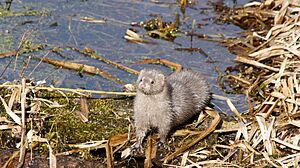
Even though the number of water rails is going down a bit, there are still a lot of them – between 100,000 and 1,000,000 adult birds! They also live across a huge area, estimated to be about 15.6 million square kilometers (6 million square miles). Because of this, they are listed as "least concern" on the IUCN Red List. This means they are not currently in danger of disappearing.
In most European countries, their numbers are either stable or slowly decreasing because they are losing their wetland homes. However, in Morocco, their numbers and range are actually growing. We don't know much about their numbers in Asia, but they are common in Pakistan and Kashmir.
Animals that are brought into an area by humans, like the American mink, are a big threat to water rails on islands. Besides causing the Icelandic water rail to disappear, mink have also caused big drops in water rail numbers in the Hebrides (islands off Scotland). There, the only native animal that hunted them was the otter, which mostly eats fish. The mink came from fur farms and spread across the islands. Luckily, programs to get rid of mink and ferrets have helped water rails return to islands like Lewis and Harris. More projects are planned to help them on the Scottish mainland too.
Locally, water rail homes can be harmed by draining marshes, straightening rivers, city growth, and pollution.
Humans have eaten water rails for thousands of years. The ancient Romans ate them, and they are even shown in paintings in Pompeii. People continued to eat them through the Middle Ages and into modern times.



